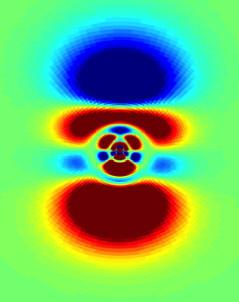Researchers unravel dynamics of electron clouds
A US-German research team has elucidated the ultra-fast dynamics of electron clouds in xenon atoms. Using attosecond technology, the scientists around Stephen R. Leone from the University of California in Berkeley were able to measure the reactions of the electrons to the strong field of an intense laser pulse in real time. Quantum mechanical modelling of the process by the team of DESY researcher Robin Santra from CFEL provided the correct interpretation of the measurements. The physicists present their joint analysis in the current isstue of Nature Physics.
Atoms consist of a positively charged nucleus surrounded by negatively charged electrons. In the quantum physics view, the electrons form a fuzzy cloud. The physicists sent bright flashes of an infrared laser into a chamber filled with xenon atoms and recorded the reaction of the xenon electrons with an extremely fast UV camera.
"In the light pulse, the electric field oscillates with a period of a few femtoseconds," explains Santra, who is a lead scientist at DESY and a physics professor at the University of Hamburg. "With even faster attosecond technique, it was possible to track the reaction of the electron cloud during the oscillations." A femtosecond is a quadrillionth of a second, equivalent to one millionth of a thousandth of a microsecond. An attosecond (quintillionth of a second) is still a thousand times shorter.
Snapshot of the electron cloud of a xenon atom, deformed by the instantaneous electric field of a strong laser pulse. Credit: Yi-Jen Chen/DESY
Electrons are not only spatially displaced by electromagnetic fields, they can also absorb the energy of the field which puts them in an excited state. If the energy is high enough, the electrons can even get kicked out of their atom. Physicists call this process ionization. Normally, for ionization to happen the energy of the light must exceed a characteristic threshold depending on the type of atom. In quantum physics, however, a so-called tunnel effect can allow quantum objects like electrons to tunnel through an energy barrier. Through the tunnel effect, ionization can occur even at an energy that is normally too low.
The scientists expected exactly this effect in their investigations of xenon. "In the experiment, however, there was a surprise: Although the xenon atoms were expected to be ionized by the tunnel effect, the quantum mechanical analysis showed that only a part of the so-called wave packet with which the electrons are described in quantum mechanics, is actually ionized," says Santra. "Another part is distorted by the oscillating electric field of the laser and always snaps back to its ground state when the oscillating field passes through zero. Just think of a spring that is periodically stretched and relaxed again."
This dichotomy between irreversible ionization and reversible polarization of the electron clouds can be understood in the context of quantum mechanics. "One might think that in a weak field the purely reversible process is present, while in the case of very strong fields the purely irreversible process prevails," Santra describes. "However, as we have shown, this clear separation does not exist."
